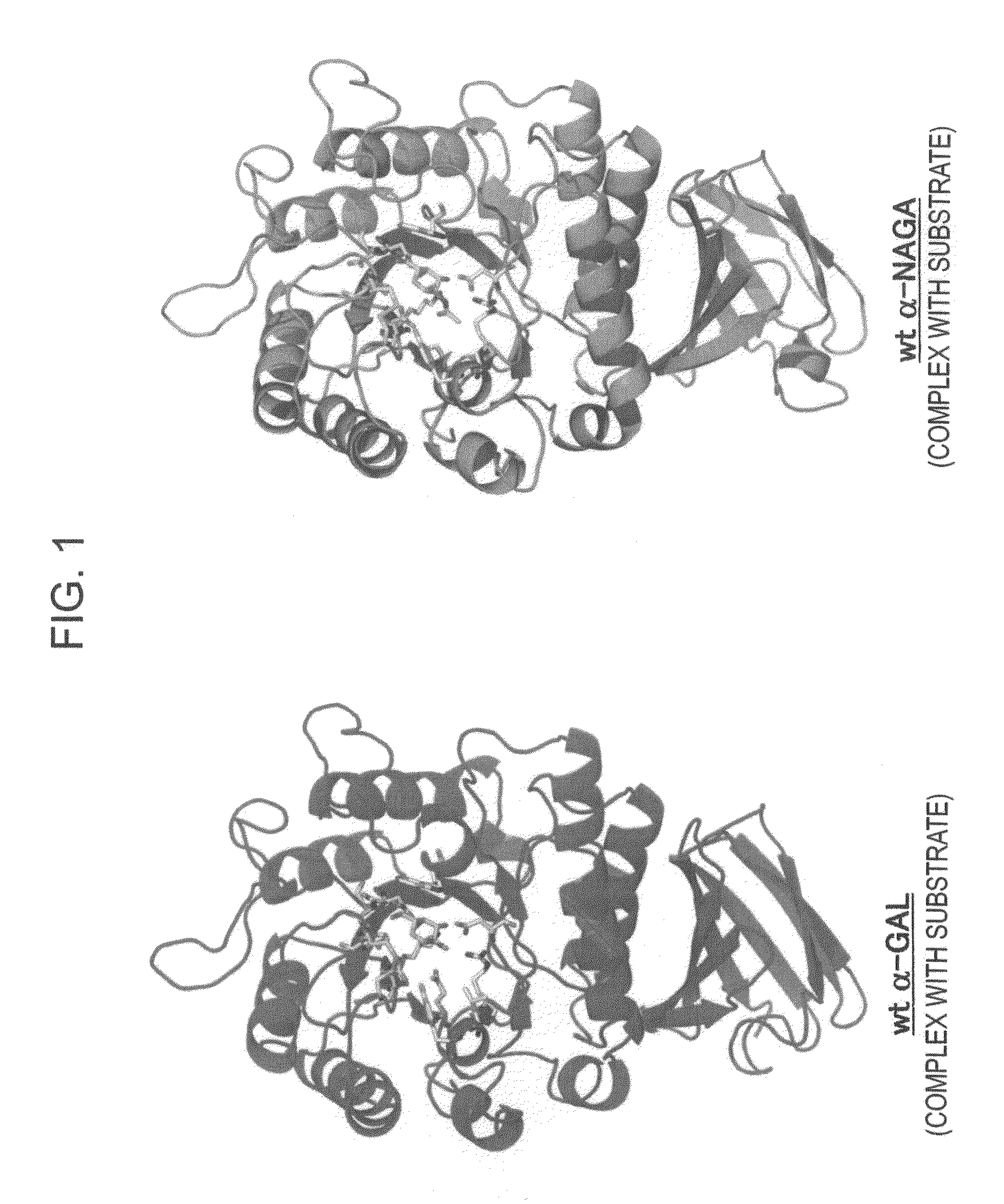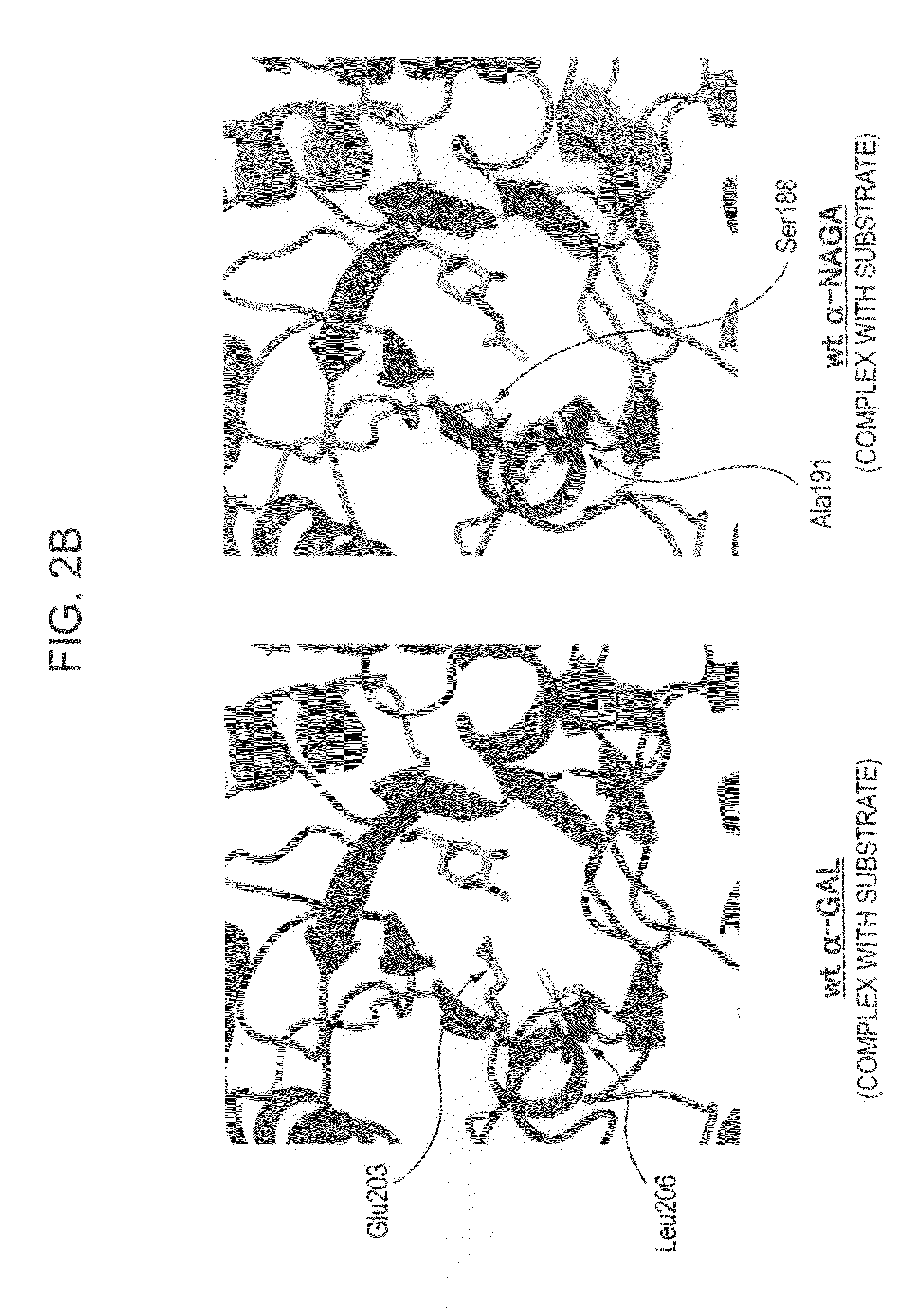Highly functional enzyme having α-galactosidase activity
a high-functional, enzyme-based technology, applied in the direction of peptide/protein ingredients, drug compositions, metabolic disorders, etc., can solve the problems of low incorporation efficiency into the cell of an affected organ, large burden on patients in the actual therapy, etc., to achieve the effect of reducing the burden on patients physically, reducing the burden on patients, and increasing the therapeutic
- Summary
- Abstract
- Description
- Claims
- Application Information
AI Technical Summary
Benefits of technology
Problems solved by technology
Method used
Image
Examples
example 1
Selection of Mutation Sites to be Introduced into α-N-acetylgalactosaminidase (α-NAGA)
[0172]In order to design a novel enzyme in which the substrate specificity of human α-NAGA is modified into a substrate specificity similar to that of human α-GAL, sites (locations of an amino acid) of mutation to be introduced into human α-NAGA were determined by comparison and study using three-dimensional structural models of proteins. The procedure and results of the determination are specifically described below.
1. Used Data
[0173]The amino-acid sequence data of human α-NAGA and human α-GAL which are registered in Swiss-Prot as described below were used. The protein three-dimensional structural data of chicken α-NAGA and human α-GAL which are registered in Protein Data Bank (PDB) as described below were used.[0174](1) Amino-Acid Sequence Data
[0175]Used data base: Swiss-Prot (tw.expasy.org / uniprot / )
[0176]
entry nameaccession numberHuman α-NAGANAGAB_HUMANP17050Human α-GALAGAL HUMANP06280[0177](2) ...
example 2
1. Preparation of α-N-acetylgalactosaminidase (α-NAGA) retrovirus vector
[0201]An α-NAGA cDNA clone (Homo sapiens N-acetylgalactosaminidase, alpha, m-RNA, Gene Bank Accession: BC000095, IMAGE: 3504221) was purchased from Open Biosystems. The coding sequence of α-NAGA was amplified by PCR with a reaction mixture composition and under a reaction condition described below, using the purchased α-NAGA cDNA as a template with primers described below and KOD-plus-polymerase (Toyobo Co., Ltd.).
[0202]
NAGA-5′ primer:5′-GATGCTGCTGAAGACAGTGCTCTT-3′(sequence No. 5)NAGA-3′ primer:5′-TCACTGCTGGGACATCTCCAGGTT-3′(sequence No. 6)
[0203]
[0204]
Template (10 ng / μL):1 μL10 × buffer:10 μL 2.5 mM dNTP:10 μL 25 mM MgSO4:4 μLKOD-plus-polymerase:1 μLNAGA-5′ primer (10 μM):1 μLNAGA-3′ primer (10 μM):1 μLSterilized water:68 μL Total:100 μL
[0205]
[0206]The reaction mixture was heated at 94° C. for two minutes. Subsequently, a cycle consisting of “thermal denaturation and dissociation: 94° C. (15 seconds)→annealing:...
example 3
Transition of Enzyme Activity of α-NAGA mutant
[0247]The fact that the mutant α-NAGA (α-NAGA S188E / A191L) had acquired the substrate specificity of α-GAL was confirmed by the following procedure.
[0248]First, a gene of wild-type α-NAGA or a gene of α-NAGA S188E / A191L was introduced into fibroblasts (F377) derived from a Fabry patient, and α-GAL activity and α-NAGA activity were measured. F377 cells were used as a negative control of α-GAL activity, and fibroblasts (F652) derived from a patient with Kanzaki disease (α-NAGA deficiency) were used as a negative control of α-NAGA activity. In addition, fibroblasts (F592) derived from a normal subject were used as a positive control of endogenous α-GAL activity and α-NAGA activity.
[0249]The cells cultured in a 60-mm dish were recovered and resuspended in Milli-Q water. The suspension was then subjected to an ultrasonic treatment to prepare a cell homogenate. This homogenate was used as a sample of an enzyme solution. The enzyme activity was...
PUM
| Property | Measurement | Unit |
|---|---|---|
| temperature | aaaaa | aaaaa |
| temperature | aaaaa | aaaaa |
| temperature | aaaaa | aaaaa |
Abstract
Description
Claims
Application Information
 Login to View More
Login to View More - R&D
- Intellectual Property
- Life Sciences
- Materials
- Tech Scout
- Unparalleled Data Quality
- Higher Quality Content
- 60% Fewer Hallucinations
Browse by: Latest US Patents, China's latest patents, Technical Efficacy Thesaurus, Application Domain, Technology Topic, Popular Technical Reports.
© 2025 PatSnap. All rights reserved.Legal|Privacy policy|Modern Slavery Act Transparency Statement|Sitemap|About US| Contact US: help@patsnap.com



